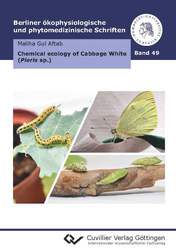| Areas | |
|---|---|
| Serie de libros (96) |
1378
|
| Nachhaltigkeit |
3
|
| Gesundheitswesen |
1
|
| Letra |
2364
|
| Ciencias Naturales |
5406
|
| Matemática | 229 |
| Informática | 319 |
| Física | 980 |
| Química | 1363 |
| Geociencias | 131 |
| Medicina humana | 243 |
| Estomatología | 10 |
| Veterinaria | 108 |
| Farmacia | 147 |
| Biología | 835 |
| Bioquímica, biología molecular, tecnología genética | 121 |
| Biofísica | 25 |
| Nutrición | 45 |
| Agricultura | 1004 |
| Silvicultura | 201 |
| Horticultura | 20 |
| Ecología y conservación de la tierra | 148 |
| Ciencias Ingeniería |
1793
|
| General |
98
|
|
Leitlinien Unfallchirurgie
5. Auflage bestellen |
|
Erweiterte Suche
Chemical ecology of Cabbage White (Pieris sp.) (Volumen 49) (Tienda española)
Maliha Gul Aftab (Autor)Previo
Lectura de prueba, PDF (6,9 MB)
Indice, PDF (110 KB)
Under the widespread concept of integrated pest management, use of semiochemicals have been extensively studied to control agricultural pest insects. In this regard, aphrodisiac pheromones of two most destructive pest species of Pieris have been investigated. Individual pheromone constituents produced in the wings of two Asian populations were compared with two European populations of P. rapae. The total pheromone levels in the European populations were lower than the amounts present in wings of Asian populations. As a result of this study, we can conclude that both the subspecies of P. rapae showed a clear variation in pheromone profile between them. On the other hand, within subspecies, the different populations did not show very large differences. Therefore, the populations with geographical difference could not be considered identical as they showed significant quantitative differences in pheromone profiles. Furthermore, Electroantennographic analysis was also carried out to find out specific pheromone lures, which could be used for both the subspecies to carried out field bioassays in future, to test the mating disruption strategy.
| ISBN-13 (Impresion) | 9783736974982 |
| ISBN-13 (E-Book) | 9783736964983 |
| Formato | A5 |
| Idioma | Inglés |
| Numero de paginas | 122 |
| Laminacion de la cubierta | mate |
| Edicion | 1. |
| Serie | Berliner ökophysiologische und phytomedizinische Schriften |
| Volumen | 49 |
| Lugar de publicacion | Göttingen |
| Lugar de la disertacion | Berlin |
| Fecha de publicacion | 06.10.2021 |
| Clasificacion simple | Tesis doctoral |
| Area |
Agricultura
|
| Palabras claves | Chemical ecology, cabbage white butterfly, Butterfly, Pieris, Schmetterling, chemische Ökologie, Kohlweißling, Schädlinge, Semiochemikalien, semiochemicals, Schadinsekte, Pheromone, pest insekts, Pheromonprofile, Pheromon-Köder, pheromone profiles, pheromone lures, Phytomedizin, natürliche Chemikalien, naturally chemicals, Kairomone, Allomone, Lepidoptera-Insekten, lepidoptera insects, Botenstoffe, messenger substances, Wirtspflanze, host plant, Wirtspflanzen-Screening, host plant screening, Flügelextrakt, Population, wings extract, Indolyl-GS-Gehalt, indolyl GS levels, Entlaubungsschäden, defoliators, Schädlingsbekämpfungsstrategien, pest management strategies, Ernteverluste, crop loss, Kreuzblütler, crucifers, Nahrungskonkurrenz, food competition, Larvenwanderung, larval migration, Pflanzenfresser, herbivore, Pflanzenschutz, Schmetterlingssterben |








